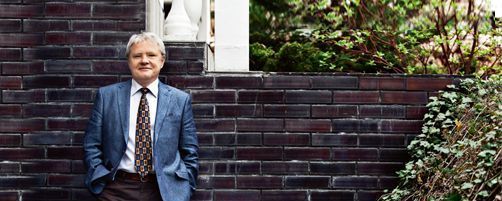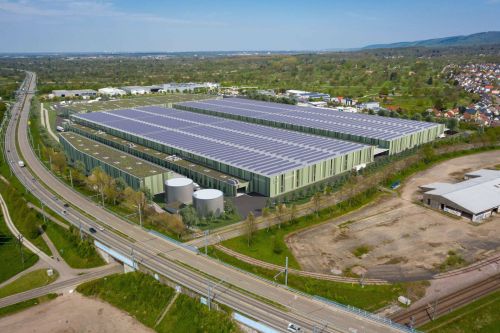The green wave that never came
Green projects
Back then, a number of developers declared that it was a matter of honour to raise awareness about the fact that "we are where we live". However, this is the beginning of a road, which - looking at the number of eco-friendly products on the market - neither buyers nor developers are ready to embark upon. Skanska Residential Development Poland is currently developing the Park Ostrobramska estate on ul. Ostrobramska in Warsaw, where 1,600 apartments will eventually be built on a 7 ha site. The first stage, the completion of which is planned for the end of 2013 or early 2014, will include 300 apartments with areas ranging from 27 sqm to 127 sqm. The project is supposed to be eco-friendly, but is not fully energy efficient, at least not at this point. "Sustainable construction is not only about energy efficient solutions but the general approach to a project, to make it friendly for the people who will become its residents. It is important for them to have access to the public transport infrastructure, retail services, as well as recreational areas. This is what we pay particular attention to. The project on ul. Ostrobramska is one such example. This is the spirit in which we would like to carry out our future projects," says Michał Melaniuk, the president of the board of Skanska Residential Development Poland. The developer will start its next project in the autumn. This will be situated on ul. Jaśminowa in Warsaw and will eventually offer around 900 apartments and houses. The average price of the apartments in the first stage of the project, which will include 220 apartments, will be PLN 8,500. The company is also planning to employ eco-friendly solutions for this project. "The challenge involves showing buyers that there is no point in waiting until 2020 when all buildings will have to have close-to-zero energy consumption. And that's why it's worth investing in such buildings today," adds Michał Melaniuk. Skanska will offer eco-friendly finishing packages for the apartments, made out of materials from sustainable resources or from recycling, with local materials (manufactured within a radius of less than 800 km from the construction site), and wood finishes with FSC (Forest Stewardship Council) certificates and systems to lower the water consumption by 30 pct. Mierzeja Development is focused on different energy efficiency solutions. Its Mierzeja Park project in the seaside town of Sztutowo is supplied with renewable energy, which provides residents with warmth in the winter and cool air in the summer. In order to achieve this, the developer decided to use geothermal installations with pumps producing about 4 kW of heating and 3 kW of cooling from each kilowatt of the energy supplied. In another project, the Osiedle Energooszczędne estate in Gdańsk, which is being developed by Towarzystwo Ziemne, apartment buyers can make substantial savings thanks to the heat recovery from the ventilation (the so-called recuperation system), heat pumps, solar panels, a ground heat exchanger (called a GWC), the velox wall construction system (which has higher performance parameters), and triple-glazed tight profile windows.
Green on paper
Skanska has ambitions to set the eco-friendly agenda for the Polish residential construction sector, which is why future stages of the Park Ostrobramska project and the project on ul. Jaśminowa will most probably be the first to be certified under the LEED for Homes system in Poland. The system conforms to the office project certificate issued by the US Green Building Council. Houses holding the LEED for Homes certificate have to be designed in such a way to increase the flow of fresh air through the rooms while clearing it of toxins and pollution. They use between 20 pct and 30 pct less energy compared to standard homes - and those with the most advanced technologies can use even 60 pct less. To obtain a certificate you need to submit the plans to the organisation and pay the required fees. In exchange you receive a detailed list of requirements and all the parameters that are monitored by auditors. A maximum of 136 points can be obtained. The building is assessed for innovativeness at the planning stage, the quality of the materials used and where they come from, the use of efficient devices, and the installation of energy efficient light fittings. As in the case of office buildings, projects are rated from basic to platinum. "In our next project - Jaśminowy Mokotów - we are planning to introduce elements that allow the buyers to receive subsidies from the National Fund for Environmental Protection and Water Management. These will include a recuperative system and stricter application of the NF40 energy efficiency standard. In the future we are also planning to obtain certification in one of the LEED systems," adds Michał Melaniuk. One initiative by Mostostal Warszawa, the Building Research Institute and the faculty of construction of the Silesian University of Technology is to establish a Polish eco-friendly standard. The MBJ2030 project focuses on the development of construction, material and installation solutions that enable the erection of multi-family buildings characterised by high energy efficiency, care for the environment and a low consumption of natural resources, while offering high comfort to their residents. The Krasińskiego 41 project, which is being developed by Fort Development in Warsaw's Żoliborz district, has been chosen as the showcase-building of this initiative. "Together with Mostostal Warszawa we want to determine the direction for the development of residential buildings in Poland by 2030. The MBJ2030 mark is to become a reliable brand and a confirmation of the fact that a building is eco-friendly and energy efficient. We consider such projects to be a niche in the market that we could utilise. We are looking for new locations for our projects in districts that exist in harmony with the environment to promote green residential building in Poland," says Tomasz Jankowski, the president of Fort Development.
Ecology is technology
A total of 70 apartments with areas ranging from 33 sqm to 108 sqm are being developed on ul. Krasińskiego. The building, which has been designed by the Galicki Sypniewski Architekci studio, will also feature eco-friendly solutions, including: the reduction of overheating in the building though the use of sliding aluminium blinds, windows positioned according to the orientation of the building, the use of 18 cm graphite polystyrene foam, noise damping concrete blocks, vents with silencers, hybrid ventilation (a combination of natural and mechanical ventilation), the retention of rainwater (which will be used for flushing toilets and watering lawns) and solar roof panels (which will be able to heat up to 35 pct of the hot water). Thanks to all these systems, energy savings of 25-35 pct should be achieved compared to traditional construction. Another Warsaw building where energy efficiency solutions can be found is Praga Square, a project by Unidevelopment. The building features mechanical ventilation equipped with recuperators. However, this was not the developer's idea. "We bought the property on ul. Goworowska in Warsaw together with a building permit and a design that involved such a solution. Despite the costs related to the installation of the recuperators, we decided to keep the parameters of the project within the architects' original plans," says Mariola Matczak-Augustyniak, the manager of the sales department at Unidevelopment.
Too expensive?
The prices on ul. Krasińskiego are not excessive, when considering that it is located in one of the most exclusive districts in Warsaw, being in the range of PLN 7,000 to PLN 10,000 per sqm. "So far we have sold 20 pct of the apartments. It is worth noting that nearly all the largest ones with big terraces or gardens have already found buyers. Because our net margin amounts to only 10 pct, the apartments sold by us are relatively inexpensive. The extra costs required for the construction of an energy efficient building amount to as much as PLN 300-350 per sqm of the useable area, and it needs to be remembered that this is not borne by the client but by us," says Tomasz Jankowski. "Developers are currently introducing eco-friendly solutions in multi-family buildings only in isolated cases, mainly due to the high construction costs of such projects, which translate into higher prices for the apartments, and the preferences of buyers, who tend to favour lower instalments rather than savings on the costs of heating spread out over a long period of time. For buyers interested in the purchase of apartments in multi-family buildings, energy efficiency is significantly down the list of their priorities compared to the price, the location, the architecture and the standard of a project. The proposed subsidies from the National Fund for Environmental Protection and Water Management are certainly not going to change buyers' preferences. The relatively small support being tabled for an apartment purchase, which ranges from PLN 11,000 to PLN 16,000, will not compensate the higher purchase costs for the buyers," says Mariola Matczak-Augustyniak of Unidevelopment. The prices of the apartments developed in the Praga Square project in Warsaw's Bródno district started at around PLN 8,400 per sqm. Tomasz Jankowski is also sceptical about the subsidies and believes that no developer will contribute so much to a project to make it possible for a client to receive only a few thousand złoty of incentives. "We would need to contribute PLN 1.5 mln to the project at Krasińskiego 41 to make it qualify for the additional financing from the National Fund for Environmental Protection and Water Management. I believe, however, that consumers are becoming increasingly aware of these issues. The problem is that they are still unable to pay more for eco-friendly properties. I suspect that a change in approach will take place only when we realise than an investment in a green apartment will be returned in the future, thanks to lower bills for the power or water and a healthier standard of living," concludes Michał Melaniuk.
Close to zero
To encourage people to buy apartments offering higher energy efficiency solutions, the National Fund for Environmental Protection and Water Management has introduced a programme of subsidies for mortgage interest rates. It is targeted at those who build a detached house with low energy consumption and those who buy such houses or apartments from a developer (including housing associations). In the case of residential units in multi-family buildings, the subsidy amounts to:
NF40 standard - EUco - a subsidy of PLN 11,000 gross
NF15 standard - EUco - a subsidy of PLN 16,000 gross.
The introduction of the programme is a direct result of the 2010/31/EU Directive of May 19th 2010 on the energy characteristics of buildings, which obliges member states to ensure all newly-developed buildings facilities have "close-to-zero energy consumption" by the end of 2020. The aim of the programme is aimed at
preparing investors, designers, construction material producers and contractors for the implementation of the directive.
Rafał Schuma the founder and president of the Polish Green Building Council
A long way ahead of us
Over the last few years we have been noticing an increase in the number of residential projects in which ecology and energy efficiency play an important role. But it would be much better if multi-criteria tools were used to manage the market, which so far has not been the case, unfortunately. The main reason is, of course, the cost of certification, for example, of the LEED, BREEAM or DGNB systems, which are still too expensive for a Polish developer when it comes to residential projects. There have been, however, a few early attempts at this type of development, such as the Baltic Park Molo residential-hotel complex. In residential buildings you can achieve much greater savings than in office properties, because of the smaller amount of hardware and installations. Using recycled 'grey water' or rain, you can easily reduce potable water consumption by 40-60 pct, and zero energy consumption buildings even have the potential for an over-production of energy. I think that all the programmes supporting sustainable construction make sense because they stimulate the market into taking action. It is important, however, to comprehensively evaluate this activity and not only focus on energy efficiency, but also on the rational management of material resources, the health and comfort of users, sustainable locations, and the indoor environmental quality - all are aspects taken into account by the certification systems mentioned.





















































